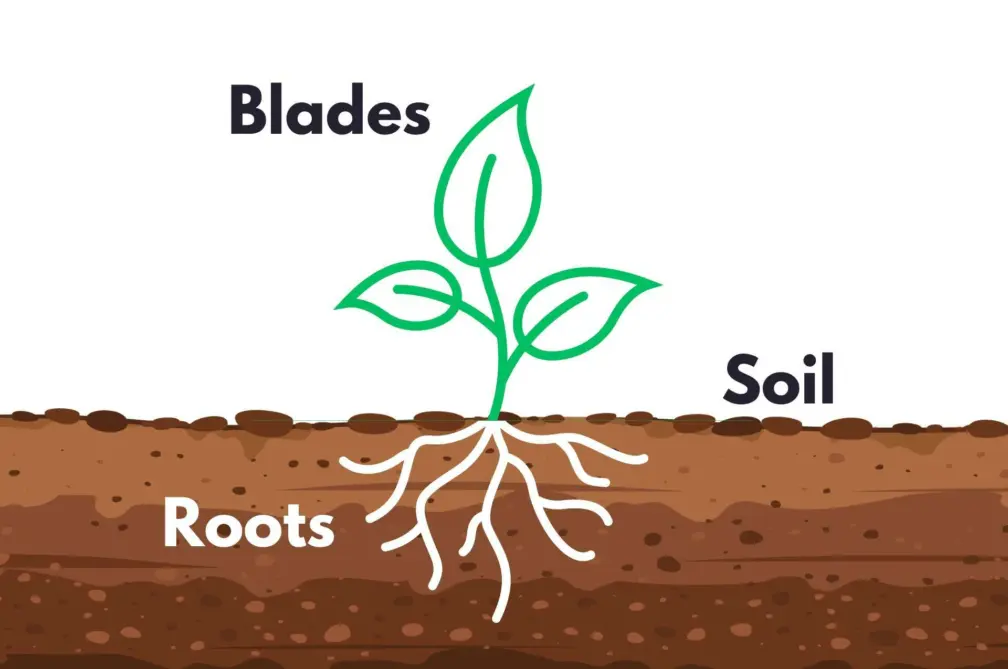Tailored Lawn Care for Healthier Gardens
Understanding the science behind how grass grows can be a game-changer for anyone wanting to provide bespoke and successful turf care.
From anatomy to nutritional needs, delving into the technical aspects of turf growth equips you with the knowledge that will make lawn maintenance a breeze, whatever the season.

Roots
The main function of grass roots is to provide stability and anchor the plant in the soil. The stronger the roots are, the more hard-wearing and durable the grass will be, as the anchorage prevents them from being uprooted by tough weather conditions or heavy foot traffic.
Whilst your turf is rooting in for the first 2-3 weeks, we recommend not walking on your it to allow the roots time to grow deep into the soil. This ensures that your turf has a strong foundation for any future foot traffic or seasonal changes. You can check the progress of your turf growth by lifting a small corner and seeing how far the roots are growing downwards.
Blades
Grass blades are one of the most important components of your turf- it’s how it stays alive. Grass blades contain a pigment called ‘Chlorophyll’, which absorb light and turns it into energy for the plant, allowing it to grow and thrive- a process known as photosynthesis.
The chlorophyll pigment has specific molecules that absorb the light and convert it into energy. This process is essential in allowing the plant to survive and to complete other essential parts of the photosynthesis process, like turning carbon dioxide and water into glucose and oxygen.
Sunlight absorption and photosynthesis are essential processes for the survival and healthy growth of grass blades and allow them to stay that lush green colour that you come to expect from healthy, thriving grass. The thicker and healthier the blades are, the more resilient they are to mowing & environmental changes.

To encourage healthy grass blades, the way that you mow is important.
You should set your mower at an appropriate cutting height and be careful not to mow too short as this can ‘scalp’ the lawn resulting in weak and brown blades.
A good tip is to remove only 1/3 of the grass height every time you mow to encourage strong blade development.
Soil
Soil plays a vital role in the upkeep and health of turf- it provides physical support, nutrients and a habitat for the various microorganisms that contribute to thriving turf.
Soil holds important nutrients for turf growth like nitrogen, phosphorous and potassium. They are absorbed into the grass by the roots and they heavily influence the health and condition of the turf.
Soil pH influences nutrient availability, so maintaining an appropriate pH level is crucial for good turf health. The optimal pH range for most garden soil is between 6.0 and 7.0 , so you should aim for a majority neutral if not slightly acidic PH and research what is best for different grass types / species.
Applying fertiliser helps provide essential nutrients to your soil by increasing the level of organic matter.
Our Rye Gold, Stadium & Budget turf are all pre-fertilised before harvesting, ensuring you’re getting the turf in the healthiest condition possible for laying.
Applying extra fertiliser can sometimes affect the nutrient balance, especially if you’re adding too much nitrogen. This can harm rather than help the turf, so it’s best to only apply fertiliser based on soil tests, visual deficiencies (yellowing leaves / stunted growth) or seasonal requirements.

Irrigation
Irrigation is one of the most important practises when it comes to lawn care. It is an essential nutrient for photosynthesis, temperature regulation and turf survival.
You should water deeply and infrequently to encourage the grass roots to grow further into the soil to access the water, this promotes a robust root system & increases the stability of your grass. Avoid frequent & shallow watering, as it can lead to underdeveloped root systems and waterlogged soil.
Watering in the morning and at night when the sun is not directly overhead reduces the possibility for evaporation and allows the turf to retain the most moisture. You should adjust your watering schedule based on the seasons- your grass is going to have different needs in hot and cold weather. During hot and dry periods, you may need to water more frequently, whilst colder & wetter weather will need less irrigation.
Understanding the science behind turf growth allows you to maintain a lush, vibrant lawn with the correct & tailored care practices in mind.


